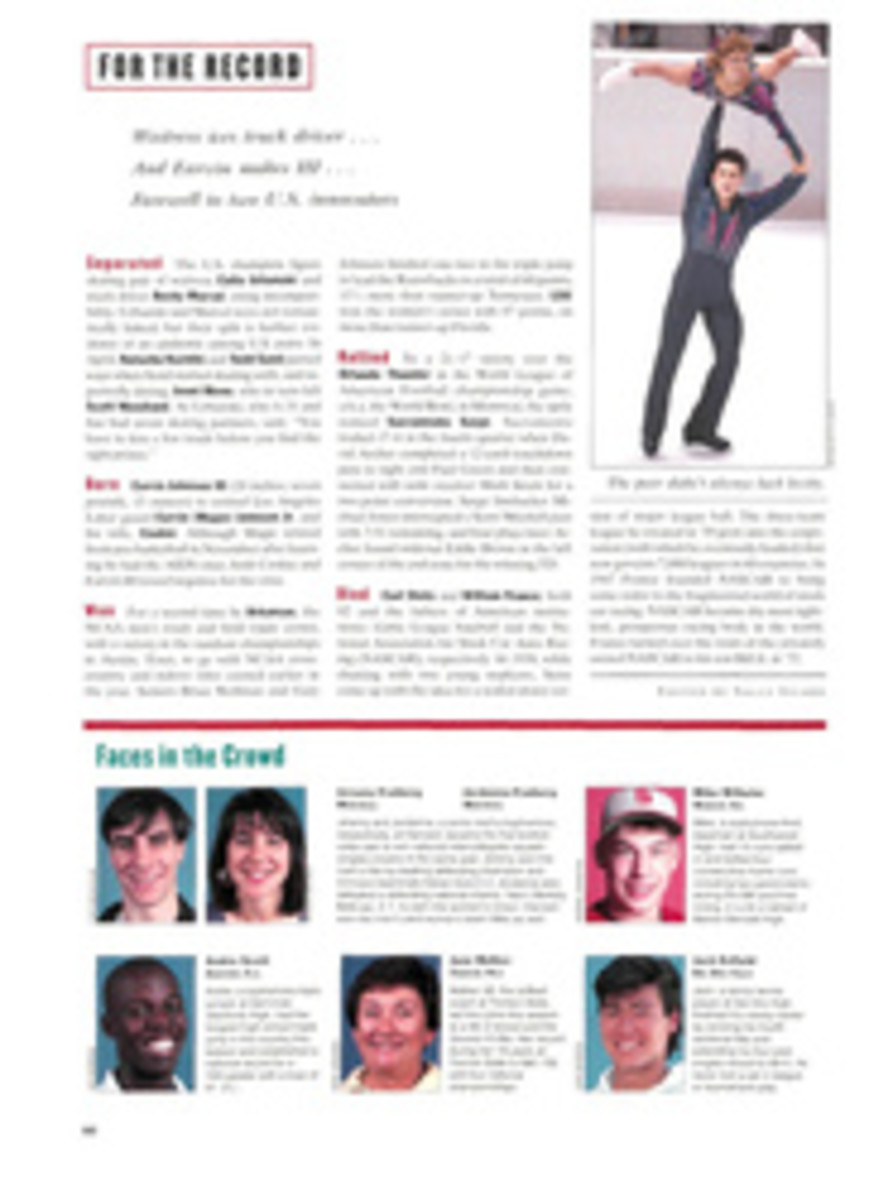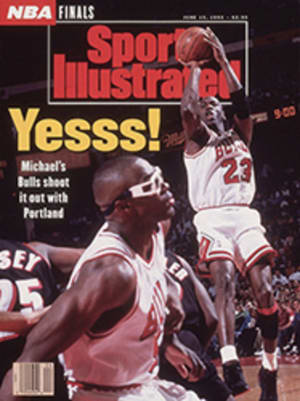
The Latest Fashion in French Diamonds
Young people sport Baseball caps, T-shirts and team jackets and speak of Nolan Ryan and Jose Canseco. Last year a department store featured a window display of replicas of 1939 New York Yankee flannels, along with balls and bats commemorating the 1927 and 1961 editions of the Bronx Bombers. Workers hustle from their offices, toting gloves and spikes, to practice in the fading sunlight.
Welcome to Paris.
Oui, Paris. France.
Baseball isn't about to replace romance or soccer as France's favorite pastimes, but it is becoming a more popular participatory sport. The Fèdèration Fran‚Äö√†√∂‚àö√ºaise de Baseball, de Softball et de Criket (la Fèdè) reports that there are some 270 baseball clubs with close to 12,000 registered players in the country, remarkable growth since 1982 when there were 30 clubs with about 2,500 players. At least 10,000 more play the game without a club affiliation and in schools. La Fèdè oversees three national divisions, with a total of 30 teams, plus more than 20 regional leagues, as well as the senior and junior national teams, several youth teams and the national softball team. There are three international class ball fields, Stade Pershing in Paris and Stade Paul Langevin in Sarcelles, north of Paris, both of which were built in 1989, and Stade de Veyrassi in Montpellier, which serves as one of the national training centers.
Baseball isn't a completely foreign concept for the French. Primary school children learn to whack a ball with a stick in a Gallic version of rounders called theque. The first French baseball club, called Ranelagh, was formed more than 70 years ago (it no longer exists), and la Fèdè was founded in 1924. Interest in the game grew again following World War II, when American soldiers there played baseball, and later, as France gave up its colonial possessions and the so-called pied noir—French citizens who had been living in North Africa—returned to France. They, too, had been exposed to baseball by occupying American troops. Similarly, U.S. troops that advanced through Italy, combined with the strong immigration links between Italy and the U.S., planted the seed that has made Italy Europe's leading baseball power since the 1950s.
Baseball's phenomenal growth since 1980 is a part of what the newspaper Le Monde called "La nouvelle vogue amèricaine." Parisians may be rude to American tourists, but they love sports that happen to be American. Basketball leads the trend, with European pros, public hoops and Olympic exposure paving the way for Magic and Michael to become household names. American football, known as le football amèricain to avoid confusion with soccer, has made fans through NFL telecasts. Now baseball is gaining popularity, thanks to its new Olympic status and broadcasts of major league baseball on French television and on cable.
Former national team technical director Jean-Jacques Louis acknowledges that fashion has helped baseball gain its French foothold. "Youngsters already dress in American baseball jackets.... But quickly they're taken with the finesse of the sport, which values individual expression in a team concept," Louis told Le Monde. Pierre Callewaert, a writer for the slick French-language American sports monthly NewSport, calls the baseball boom a "phènomène de sociètè," contending, "There's more fashion than passion to the French interest in baseball."
Gilles Thomas, 35, of Paris, learned baseball when he was in high school. He and his friends picked up the rules by watching games, "when there were 200 people playing on four or five teams." He stuck with baseball because he "liked the smell of the gloves."
Thomas has a degree in sports administration and works as a technical director for la Fèdè, promoting baseball and trying to manage its growth. He believes registered players—those who belong to a club—will top the 20,000 mark by 1995, bringing "recognition as a real sport. People now know it's played, but they think it's a fashion." Thomas hopes that a French team can qualify for the 1996 Olympics in Atlanta or for the 2000 Games, at the latest. His optimism grows out of the great strides he has witnessed over the past two decades. "The average level of play is much better now," Thomas says. "We look like ballplayers."
The French champion Paris Universitè Club's (PUC Hitachi) practice at Pershing resembles a workout at perhaps the U.S. junior college level. The park, in the Bois de Vincennes on the eastern edge of Paris, has a hand-operated scoreboard, dugouts, bleachers and fences measuring 98 meters (322 feet) down the lines and 122 meters (400 feet) in the alleys. Every day, from after school until twilight, four club teams and a dozen or more of their youth affiliates schedule practice at Pershing. They use a pitching screen and batting cage, which is pulled farther back than is customary in the U.S., so batting practice features a lot of pop-ups. Players take additional swings using a batting tee and net at the backstop.
And there are some genuine players. Philippe Bonnery didn't join an organized team until 1985, when he was 20. That year he was the centerfielder on a national squad made up of club team all-stars, and later Bonnery played junior college ball at Citrus College in California.
"Ten years ago, if you mentioned baseball to a Frenchman, he would look at you like you were from Mars," PUC captain Andrè Lebhar says. "Now, he would say, 'I've heard of it.' " When Lebhar's family—he has a French mother and an American father—returned to Paris in 1978 after a dozen years in Bay Ridge, Brooklyn, the then 16-year-old junior high school catcher put away his gear. Then his older brother, Lionel, spotted a sign at school: BASEBALL: CA EXISTE ‚Äö√†√∂‚àö√ë PARIS! The two brothers quickly signed up with the PUC club team. Andrè, a hearing-aid technician who speaks Parisian French and Brooklyn English, is now credited with showing the French the way the game should be played. He remains a catcher and second baseman for PUC as well as for the national team.
Lionel, now 30, played second base for PUC and under the pseudonym Hellel contributes to Strike, a glossy French baseball publication. Strike founder and managing editor Didier Huon owns a high-construction maintenance firm that has repaired many Paris landmarks, including Notre Dame and the Louvre. "With these jobs I can eat and get money to spend on baseball," says Huon, a 30-something former player for Paris's Broken Arm Team, popularly known as BAT. Huon, who picked up baseball from Americans while working on oil rigs in Saudi Arabia, founded the quarterly three years ago. He claims a circulation of 10,000.
Huon has served as live commentator on World Series telecasts at one of Paris's American bars and collects baseball memorabilia and photos for his office. Huon is also trying to organize public relations for la Fèdè, an uphill battle. Callewaert, who caught for PUC and still umpires and coaches Softball, believes that better statistics are essential to develop fan interest. "We need our own .368 Ty Cobb, .553 Cy Young stuff. Don't even ask who was the best frappeur in France last year," he says.
Strike is doing its part to build interest with coverage of local teams, international baseball and a sliver of major league news. Acadèmie Fran‚Äö√†√∂‚àö√ºaise be damned, French players use the terms windup, balk, stretch, full count, catcher, fungo, infield fly, bunt and foul ball. A few French words have passed muster, such as champ for outfield, plaque for home plate, arbitre for umpire and gant for glove, but hitters use la batting glove.
But baseball's U.S. connection runs deep. When Callewaert pleads for foreign coaching, saying, "We now have guys who at age 16 can chew tobacco and spit like John Wayne, but whose windups are shaky," he's also revealing how closely he links baseball to what he perceives as the heart of America.
As with other American signature items, from cars to computers, Japan has stepped in. In 1989 Japanese electronics giant Hitachi undertook sponsorship of PUC and a year later started underwriting the French national team. It provided money for such things as equipment, uniforms and a coach, Yoshio Yoshida, known as Japan's Pee Wee Reese during his playing days in the 1950s.
So now the American pastime is being taught by the Japanese to the French. Baseball has become a truly international sport.
PHOTO
CHARLIE ABAD/PRESSE SPORTS
Ex-Brooklynite Andrè Lebhar (throwing ball) is PUC's captain and coach of a junior team.
PHOTO
CHARLIE ABAD/PRESSE SPORTS
Former Japanese All-Star Yoshida is the manager of PUC.
PHOTO
CHARLIE ABAD/PRESSE SPORTS
The scoreboard at Stade Pershing, built in Paris in 1989, is hand-operated and indisputably French.
Eliot Cohen, who lives in Washington, D.C., is the editor of "Who's Who in Baseball."

